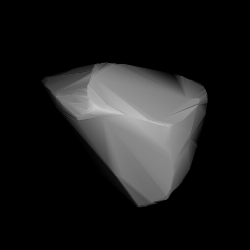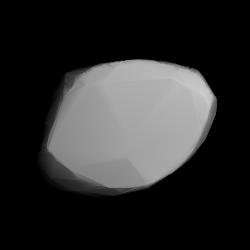
1743 Schmidt, provisional designation 4109 P-L, is a dark background asteroid from the inner regions of the asteroid belt, approximately 19 kilometers in diameter. It was discovered during the Palomar–Leiden survey on 24 September 1960, by astronomers Ingrid and Cornelis van Houten at Leiden, on photographic plates taken by Tom Gehrels at Palomar Observatory in California. The C-type asteroid has a rotation period of 17.5 hours. It was named for the optician Bernhard Schmidt.
Athalia, provisional designation 1903 ME, is a carbonaceous Themistian asteroid from the outer regions of the asteroid belt, approximately 40 kilometers in diameter. It was discovered on 20 September 1903, by German astronomer Max Wolf at the Heidelberg Observatory in southwest Germany. The asteroid was named after the ancient Judahite queen Athaliah.
Arago, provisional designation 1923 OT, is a dark asteroid from the outer regions of the asteroid belt, approximately 55 kilometers in diameter. It was discovered on 5 September 1923, by Russian astronomer Sergey Belyavsky at the Simeiz Observatory on the Crimean peninsula. The asteroid was named after French mathematician François Arago.
La Paz, provisional designation 1923 PD, is a carbonaceous asteroid from the outer region of the asteroid belt, approximately 40 kilometers in diameter. It was discovered on 31 October 1923, by German astronomer Max Wolf at the Heidelberg-Königstuhl State Observatory and named after the city La Paz in Bolivia.
1024 Hale, provisional designation A923 YO13, is a carbonaceous background asteroid from the outer regions of the asteroid belt, approximately 45 kilometers (28 miles) in diameter. The asteroid was discovered on 2 December 1923, by Belgian–American astronomer George Van Biesbroeck at the Yerkes Observatory in Wisconsin, United States. It was named for American astronomer George Ellery Hale. The dark C-type asteroid may have a rotation period of 16 hours.

1039 Sonneberga, provisional designation 1924 TL, is a dark background asteroid, approximately 34 kilometers in diameter, located in the central region of the asteroid belt. It was discovered on 24 November 1924, by German astronomer Max Wolf at Heidelberg Observatory in southwest Germany. The asteroid was named for the German city of Sonneberg, where the Sonneberg Observatory is located.
1031 Arctica, provisional designation 1924 RR, is a dark asteroid from the outer region of the asteroid belt, approximately 75 kilometers in diameter. It was discovered on 6 June 1924, by Soviet−Russian astronomer Sergey Belyavsky at Simeiz Observatory on the Crimean peninsula. It was named for the Arctic Sea.
1096 Reunerta, provisional designation 1928 OB, is an asteroid from the background population of the asteroid belt's central region, approximately 40 kilometers in diameter. It was discovered on 21 July 1928, by astronomer Harry Edwin Wood at the Union Observatory in Johannesburg, South Africa. The asteroid was named after South African engineer Theodore Reunert, supporter of the observatory and friend of the discoverer.
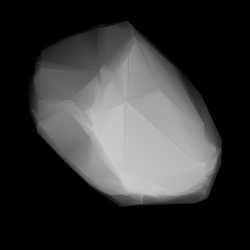
1118 Hanskya is a large background asteroid, approximately 77 kilometers in diameter, located in the outer regions of the asteroid belt. Discovered by Sergey Belyavsky and Nikolaj Ivanov in 1927, it was named after Russian astronomer Aleksey Hansky. The presumed dark C-type asteroid has a rotation period of 15.6 hours.
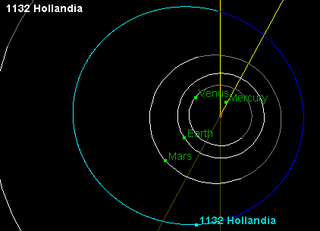
1132 Hollandia, provisional designation 1929 RB1, is a stony asteroid from the middle region of the asteroid belt, approximately 27 kilometers in diameter. It was discovered on 13 September 1929, by Dutch astronomer Hendrik van Gent at Leiden Southern Station, annex to the Johannesburg Observatory in South Africa. It was named for the region Holland in the Netherlands.
1581 Abanderada, provisional designation 1950 LA1, is a dark Themistian asteroid from the outer regions of the asteroid belt, approximately 35 kilometers in diameter. It was discovered on 15 June 1950, by Argentine astronomer Miguel Itzigsohn at the La Plata Astronomical Observatory in La Plata, Argentina. The asteroid was named after Eva Perón.
11277 Ballard (provisional designation 1988 TW2) is a Phocaea asteroid from the inner regions of the asteroid belt, approximately 6.3 kilometers (3.9 miles) in diameter. It was discovered on 8 October 1988, by American astronomer couple Carolyn and Eugene Shoemaker at the Palomar Observatory in California. The assumed S-type asteroid has a rotation period of at least 10 hours. It was named for American marine scientist Robert Ballard.
1569 Evita, provisional designation 1948 PA, is a dark background asteroid from the outer regions of the asteroid belt, approximately 36 kilometers in diameter. It was discovered on 3 August 1948, by astronomer Miguel Itzigsohn at the La Plata Astronomical Observatory in Argentina. The asteroid was named after Eva Perón.
1589 Fanatica, provisional designation 1950 RK, is a stony, Vestian asteroid from the inner regions of the asteroid belt, approximately 11 kilometers in diameter. It was discovered on 13 September 1950, by Argentine astronomer Miguel Itzigsohn at La Plata Astronomical Observatory in La Plata, Argentina. It was named after Eva Perón.
1267 Geertruida, provisional designation 1930 HD, is a carbonaceous background asteroid from the inner regions of the asteroid belt, approximately 20 kilometers in diameter. Discovered by astronomer Hendrik van Gent at Johannesburg Observatory in 1930, the asteroid was later named after Geertruid Pels, sister of Dutch astronomer Gerrit Pels.
2571 Geisei, provisional designation 1981 UC, is a stony Florian asteroid from the inner regions of the asteroid belt, approximately 6 kilometers in diameter. It was discovered by Japanese astronomer Tsutomu Seki at Geisei Observatory on 23 October 1981, and named for the Japanese village of Geisei.
6255 Kuma, provisional designation 1994 XT, is a carbonaceous asteroid from the central region of the asteroid belt, approximately 22 kilometers in diameter. It was discovered on 5 December 1994, by Japanese astronomer Akimasa Nakamura at Kuma Kogen Astronomical Observatory on the Island of Shikoku, Japan. It was named after the Japanese town of Kumakōgen.
1383 Limburgia, provisional designation 1934 RV, is a carbonaceous asteroid from the outer region of the asteroid belt, approximately 23 kilometers in diameter. It was discovered on 9 September 1934, by Dutch astronomer Hendrik van Gent at the Leiden Southern Station, annex to the Johannesburg Observatory in South Africa. It is named for the Dutch province Limburg.
1303 Luthera, provisional designation 1928 FP, is a dark asteroid and the parent body of the Luthera family, located in the outermost regions of the asteroid belt. It measures approximately 90 kilometers in diameter. The asteroid was discovered on 16 March 1928, by astronomer Friedrich Schwassmann at the Bergedorf Observatory in Hamburg, Germany, and later named after German astronomer Robert Luther.
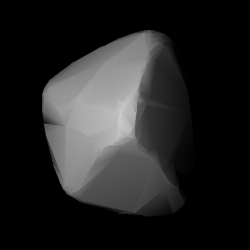
2120 Tyumenia is a dark background asteroid, approximately 45 kilometers in diameter, located in the outer regions of the asteroid belt. It was discovered on 9 September 1967, by Soviet astronomer Tamara Smirnova at the Crimean Astrophysical Observatory in Nauchnyj, on the Crimean peninsula. The asteroid was named for the now Russian district of Tyumen Oblast in Western Siberia.
